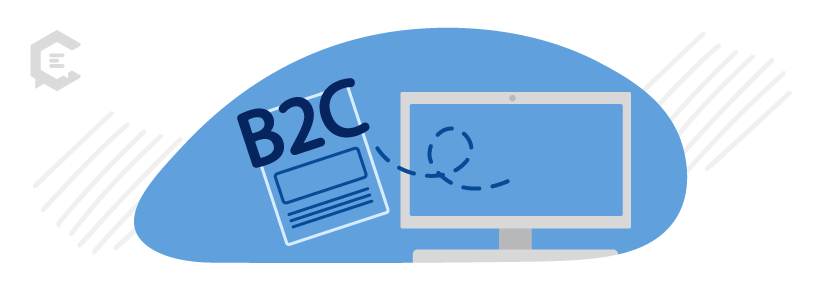Anyone in marketing knows that traditional advertising doesn’t cut it anymore. You need to create engaging content that provides real value to your audience.
That’s where B2C content marketing shines.
70 percent of B2C marketers said content marketing has become more important to their organization in the past year. And with the oversaturation of content online, a strong B2C content marketing strategy can be the difference maker for your business.
In this article, we’ll unpack the importance of B2C content marketing. Then, we’ll guide you through a framework for delivering compelling content that connects with your audience and drives your brand’s success.

Understanding B2C Content Marketing
Understanding B2C content marketing starts with understanding your audience. You need to have a deep knowledge of their pain points, wants, and needs. Then, you can strategically craft content that meets those needs and answers the questions they’re asking.
But before we get too deep, let’s break down what B2C content marketing is.
The Definition of B2C Content Marketing
B2C stands for “Business to Consumer.” At its core, it’s a marketing approach that focuses on creating customer-centric content that attracts, engages, and retains consumers. It’s less about promoting products or services and more about building lasting relationships with your audience.
How B2C marketing is different from traditional advertising
Traditional advertising is all about selling. It often relies on persuasion and even manipulation to get the audience to take a desired action.
That’s not the case with B2C marketing. B2C content aims to provide genuine value to an audience. It educates, entertains, and inspires instead of pushing a hard sell.
The Importance of B2C marketing to the success of your business
In today’s marketplace, consumers care about connecting with brands.
- 76 percent say they buy from brands they feel connected to over competitors
- 57 percent increase their spending with a brand they feel connected to
- 70 percent are less likely to shop from a brand they don’t connect to
- 61 percent will spend less with that same business
Source: Sprout Social
What does that practically mean for your brand if you use B2C content marketing? Well, let’s break it down:
- Brand trust and loyalty: The connection B2C content marketing establishes trust and credibility with your target audience. That leads to lasting relationships and customer retention.
- Increased engagement: Effective B2C content attracts more organic traffic to your brand’s distribution channels.
- Build authority: By speaking directly to customers’ pain points and needs, you also educate and inform them about your solutions. That establishes your brand’s expertise and thought leadership.
- Enhanced visibility: Relevance to search queries has become one of the top factors for search engine rankings. Crafting high-quality B2C content that answers your audience’s questions will catapult you up the search rankings.
Crafting Compelling B2C Content
High-quality B2C content doesn’t just happen. You need to have a strategic framework in place to set yourself up for success.
Research your audience
Like any successful marketing initiative, research is critical before creating your B2C content. Learn who your current customer is. What defines them demographically? What are their pain points? Why do they feel the way that they do?
Envision who your ideal customer is and compare it to your current buyer. They may look different. The better defined they are, the better you can target them in your content marketing.
Create buyer personas for your target audience that include:
- What challenges buyers routinely face
- How your product or service solves the buyer’s pain points
- What current buyers like about your product or service
Your understanding of your customers will influence everything around your content.
Gather feedback
Go beyond your marketing team to learn more about your audience. Your customer service team that answers questions for customers and knows their problems is a great place to start.
Learn about what FAQs they encounter. Ask about the most common customer pain points.
Talk to anyone who interacts with your customers directly, like salespeople. What do they observe from customers? What techniques do your sales team members use to sell more?
Also, ask your SEO team for insights. What are the latest Google trends and hot topics that relate to your target audience? What search intent is driving leads to your website? What interesting topics are your competitors covering that you could write about in a unique way?
Use market research and audience analysis to build as comprehensive a profile as possible on your customers.
Map out your customer’s journey
Take the buyer personas you’ve created and map out what kind of customer journey they’ll take with your brand. The sales funnel covers the following:
- Awareness stage
- Consideration stage
- Decision stage
At each stage in the customer journey, write out questions the customer might be asking or their considerations. What information would help move them to the next part of the journey?
These details can provide a ton of ideas for what to create in your B2C content.
Use content planning
Once you know your ideal customer and what they’re experiencing along the consumer journey, it’s time to plan out your content creation.
During the content ideation process, think about good content ideas that:
- Provide helpful information for what leads are searching for
- Educate leads and customers about your product or service
- Explain what makes your company stand out
- Feature strong keywords
- Stand out from competitors
Employ web content best practices
In addition to what you create, you’ll want to make your content user-friendly.
For written content, make your writing scannable. Break it up with subheads, bullet points, and/or numbered lists. This formatting keeps your audience engaged.
Also, implement calls-to-action (CTA) in each post. Ideally, you’d want people to spend as much time on your website as possible. Add a call-to-action that points them to another post, page, or action on your website so they keep interacting with your content.
Before you publish your content, get an editor’s eyes on it. Your B2C content reflects your brand. Misspellings, grammar mistakes, or offensive content could harm your brand’s reputation. Ensure you’re confident in how your content represents your business before sharing it.
Distribution
Once your B2C content is created, the right content distribution will maximize its reach and impact. Make sure you’re using the channels where your target audience is to ensure you attract and engage the right people. Here’s a couple ideas of how to do that;
- Leverage social media
- Email marketing
- Content syndication
- SEO
- Online community engagement
- Influencer partnership
Don’t forget the emotion
We mentioned that B2C content marketing is all about taking a customer-centric approach. One goal should be at the heart of your content creation — creating an emotional connection with your audience.
Emotion is what drives us as people. We rely heavily on our emotions to make decisions. Make sure your content uses the power of emotional hooks to grab your audience’s attention and pull them into the narrative you’re creating around your product or service.
Measuring Your B2C Success
Your brand’s success will depend on how well you understand the impact of your content efforts and make data-driven adjustments. Let’s explore some critical tools and strategies to accurately assess your content’s performance.
Defining key performance indicators (KPIs)
Figure out which KPIs align with your B2C content marketing goals. It could be tracking website traffic, conversion rates, email open rates, or social media engagement. Whichever you choose will provide a compass for refining your content moving forward.
Using analytics tools
There are a ton of tools you can use to measure your content’s success. Here are a few:
- Google Analytics: Offers engagement metrics like page visits, time on page, and click-through rates.
- SEO tools: Semrush or Ahrefs have tools that help you hone in on your audience through keyword research and clustering.
- Social Media Engagement: The beauty of social media is that it’s a straight link to your audience. You can talk to them directly and analyze what’s working through likes, shares, and comments.
- Surveys and Quizzes: These take a little more legwork but can be really effective. Don’t be afraid to ask your audience directly for feedback on the content, what’s working, and what isn’t.
Content performance audits
As you’re gathering all these metrics, you’ll want to apply them to each piece of content within your strategy. Regular content performance audits can help you evaluate the effectiveness of your existing content. You’ll be able to identify top-performing assets, content gaps, and opportunities for improvement.
How Are You Feeling About Your B2C Content Strategy?
Alright, that’s a pretty comprehensive framework for your B2C content marketing. These guidelines will help drive your B2C content’s effectiveness and maximize its impact. But if you want to go a step further, ClearVoice is here.
Sometimes, the smartest solution is outsourcing your content to a proven content agency with top-tier B2C content and strategy services. Talk to a specialist today to discover what we can do for you.







